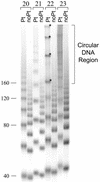DNA bending and unwinding due to the major 1,2-GG intrastrand cross-link formed by antitumor cis-diamminedichloroplatinum(II) are flanking-base independent
- PMID: 12087174
- PMCID: PMC117060
- DOI: 10.1093/nar/gkf405
DNA bending and unwinding due to the major 1,2-GG intrastrand cross-link formed by antitumor cis-diamminedichloroplatinum(II) are flanking-base independent
Abstract
Antitumor cisplatin [cis-diamminedichloroplatinum(II)] forms on DNA predominantly intrastrand cross-links between neighboring purine residues. Several discoveries suggested that the toxicity of cisplatin originated from these lesions. The formation of 1,2-GG intrastrand cross-link of cisplatin leads to marked conformational alterations in DNA including a directional, rigid bend toward the major groove and local unwinding. These altered structures attract various cellular proteins. This phenomenon has been postulated to mediate antitumor properties of cisplatin. Importantly, the binding affinity of several proteins that specifically recognize 1,2-GG intrastrand cross-link to platinated DNA is modulated by the nature of the base pairs that immediately flank the platinated d(GpG) site. However, the influence of sequence context on DNA bending and unwinding due to the formation of the 1,2-GG intrastrand cross-link has not been extensively investigated. In the present study we have employed electrophoretic retardation (phasing) assay to analyze bending and unwinding induced by the single, site-specific 1,2-GG intrastrand cross-link immediately flanked by various bases formed by cisplatin in nine oligodeoxyribonucleotide duplexes. The results indicate that bending and unwinding of DNA as a consequence of the formation of the major adduct of cisplatin is, in the first approximation, independent of the base pairs flanking the platinated d(GpG) site.
Figures



Similar articles
-
Conformational rearrangement of 1,2-d(GG) intrastrand cis-diammineplatinum crosslinked DNA is driven by counter-ion penetration within the minor groove of the modified site.J Mol Model. 2017 Sep 14;23(10):278. doi: 10.1007/s00894-017-3445-2. J Mol Model. 2017. PMID: 28913561
-
DNA unwinding produced by site-specific intrastrand cross-links of the antitumor drug cis-diamminedichloroplatinum(II).Biochemistry. 1991 Aug 13;30(32):8026-35. doi: 10.1021/bi00246a021. Biochemistry. 1991. PMID: 1868076
-
HMG-domain protein recognition of cisplatin 1,2-intrastrand d(GpG) cross-links in purine-rich sequence contexts.Biochemistry. 2000 Sep 26;39(38):11771-6. doi: 10.1021/bi001352l. Biochemistry. 2000. PMID: 10995245
-
Interstrand cross-links of cisplatin induce striking distortions in DNA.J Inorg Biochem. 1999 Oct;77(1-2):23-9. doi: 10.1016/s0162-0134(99)00148-8. J Inorg Biochem. 1999. PMID: 10626349 Review.
-
Trans-diammineplatinum(II): what makes it different from cis-DDP? Coordination chemistry of a neglected relative of cisplatin and its interaction with nucleic acids.Met Ions Biol Syst. 1996;33:105-41. Met Ions Biol Syst. 1996. PMID: 8742842 Review.
Cited by
-
Impacts of amino acid-linked platinum(II) complexes on DNA structure.J Biol Inorg Chem. 2025 Feb;30(1):87-101. doi: 10.1007/s00775-025-02097-x. Epub 2025 Jan 24. J Biol Inorg Chem. 2025. PMID: 39853368 Free PMC article.
-
Cisplatin induces loop structures and condensation of single DNA molecules.Nucleic Acids Res. 2009 Apr;37(5):1400-10. doi: 10.1093/nar/gkn933. Epub 2009 Jan 7. Nucleic Acids Res. 2009. PMID: 19129234 Free PMC article.
-
Multiscale modeling of double-helical DNA and RNA: a unification through Lie groups.J Phys Chem B. 2012 Jul 26;116(29):8556-72. doi: 10.1021/jp2126015. Epub 2012 Jun 7. J Phys Chem B. 2012. PMID: 22676719 Free PMC article.
-
Chiral differentiation of DNA adducts formed by enantiomeric analogues of antitumor cisplatin is sequence-dependent.Biophys J. 2005 Jun;88(6):4159-69. doi: 10.1529/biophysj.104.054650. Epub 2005 Apr 1. Biophys J. 2005. PMID: 15805172 Free PMC article.
-
Translesion activity of PrimPol on DNA with cisplatin and DNA-protein cross-links.Sci Rep. 2021 Sep 2;11(1):17588. doi: 10.1038/s41598-021-96692-y. Sci Rep. 2021. PMID: 34475447 Free PMC article.
References
-
- Johnson N.P., Butour,J.-L., Villani,G., Wimmer,F.L., Defais,M., Pierson,V. and Brabec,V. (1989) Metal antitumor compounds: the mechanism of action of platinum complexes. Prog. Clin. Biochem. Med., 10, 1–24.
-
- Reedijk J. and Teuben,J.M. (1999) Platinum-sulfur interactions involved in antitumor drugs, rescue agents and biomolecules. In Lippert,B. (ed.), Cisplatin. Chemistry and Biochemistry of a Leading Anticancer Drug. Wiley-VCH, Weinheim, Germany, pp. 339–362.
-
- Eastman A. (1987) The formation, isolation and characterization of DNA adducts produced by anticancer platinum complexes. Pharmacol. Ther., 34, 155–166. - PubMed
-
- Fichtinger-Schepman A.M.J., Van der Veer,J.L., Den Hartog,J.H.J., Lohman,P.H.M. and Reedijk,J. (1985) Adducts of the antitumor drug cis-diamminedichloroplatinum(II) with DNA: formation, identification and quantitation. Biochemistry, 24, 707–713. - PubMed
-
- van de Vaart P.J.M., Belderbos,J., de Jong,D., Sneeuw,K.C.A., Majoor,D., Bartelink,H. and Begg,A.C. (2000) DNA-adduct levels as a predictor of outcome for NSCLC patients receiving daily cisplatin and radiotherapy. Int. J. Cancer, 89, 160–166. - PubMed

